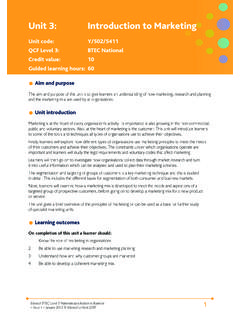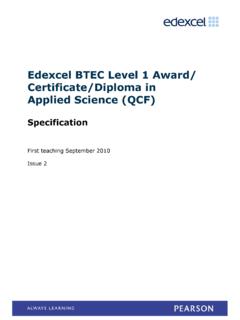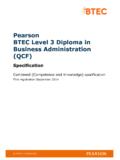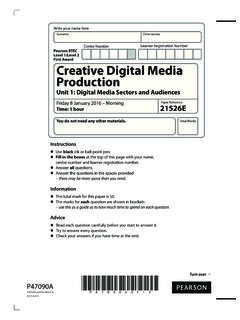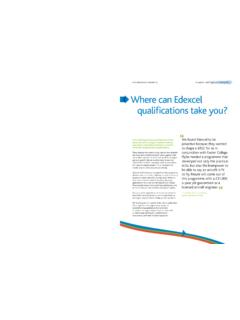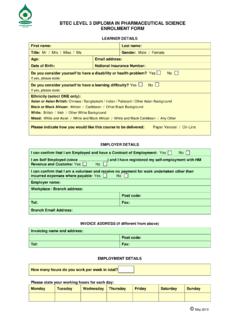Transcription of Unit 10: Market Research in Business - Learn Marketing
1 Unit 10: Market Research in Business Unit code: H/502/5427. QCF Level 3: btec National Credit value: 10. Guided learning hours: 60. Aim and purpose The aim of this unit is to enable learners to develop an understanding of the fundamental concepts that underpin why businesses collect data about their Market , how they collect and interpret it and how it can be used to support Marketing decisions. Unit introduction It is generally accepted that having the appropriate information is the foundation of all good Business decisions, and Marketing information is, therefore, the basis of good Marketing decisions. The ability to collect information and data about the Business environment, markets and customers has been transformed by technological advances.
2 The main Research challenge today is to find the best information amongst a large amount of data, rather than finding scarce data, as was the case in the past. Market Research is carried out in all areas of Marketing activities and the information collected concerns customers, markets, responses to existing and planned Marketing campaigns and the general Business environment. This means that the process needs to be continuous so that trends, opportunities and threats are identified. In this unit learner knowledge of the main types and sources of Market Research will be developed. They will Learn about the main Research methods used to collect data and how to decide on the most appropriate method for a given situation. This will take into account organisational objectives and the constraints that businesses work within.
3 Learners will also Learn how data is analysed, interpreted and presented so that the Research objectives are met. Learners will have the opportunity to plan and carry out some simple Market Research activities and to interpret their findings. Learning outcomes On completion of this unit a learner should: 1 Understand the main types of Market Research used to make Marketing decisions 2 Be able to plan Research 3 Be able to carry out Research 4 Be able to interpret Research findings. Edexcel btec Level 3 Nationals specification in Business Issue 2 June 2010 Edexcel Limited 2010. 1. Unit content 1 Understand the main types of Market Research used to make Marketing decisions Primary Research : observation; experimentation; surveys, eg face-to-face, postal, email, telephone; e- Marketing Research ; focus groups; panels; field trials; piloting; appropriateness of each method eg fitness for purpose, cost, accuracy, time, validity, response rate Secondary Research : internal sources eg data records, loyalty schemes, EPOS (electronic point of sale), website monitoring, e-transactions, accounting records, production information, sales figures, sales personnel, Delphi technique.
4 External sources eg internet, Government statistics, libraries, universities, company reports, specialist agencies eg Mintel, Datastream, Dun & Bradstreet; trade journals; criteria for selection eg checking of validity; use of ICT applications eg storing, organising, retrieving and reporting data Qualitative and quantitative Research : importance and use of each; triangulation Marketing strategies and activities: eg strategic, technical, databank, continuous, ad hoc Research 2 Be able to plan Research Stages: brief; defining the issue; setting objectives; planning data to be collected, eg methods of collection, who is to collect it, timings; types of data, eg internal, external, secondary, primary; target population Research stages: proposal/brief; defining objectives; planning; forecasting; collection of data; analysis and evaluation of data; presentation of findings; making recommendations; re-evaluation of Marketing activities Purpose of Research objectives: understand customer behaviour, buying patterns, preferences, satisfaction, sales trends; brand awareness; advertising awareness; product development success; new product opportunities; changes in the Market ; emergence of new markets; PESTLE (political, economic, social, technological, legal, environmental); competitor activities 3 Be able to carry out Research Census versus sample: sample size, choosing the sample.
5 Probability sampling, eg random, systematic random, stratified random, multi-stage, cluster; non-probability, eg quota, convenience, observation, focus group, judgement; implications of different samples; cost and accuracy of information Questionnaire: design, questions to be asked; types of questions eg sequencing, dichotomous, multiple choice, scaled, open ended; length of questionnaire; bias; relevance; response; pilot stage Survey: design; objectives, eg of what, where, when, how; difference between survey and questionnaire 4 Be able to interpret Research findings Statistical procedures: arithmetic mean; median; mode; range; inter-quartile range; scatter diagrams;. times series; trends; use of spreadsheets for analysis Presentation of findings: oral reports; written reports eg formal, informal; visual aids eg computer graphics, graphs, charts; presentation of conclusions and recommendations; audience; effectiveness; quality of information; facilities Diagrammatic analysis and presentation: pictograms; pie charts; bar charts; frequency curves; histograms.
6 Line graphs; scattergrams; appropriate use of techniques; interpretation of results Limitations of Research : excess of information through customer databases; problems of e- Business feedback overload; reliability of sample; accuracy, bias; subjectivity Edexcel btec Level 3 Nationals specification in Business 2 Issue 2 June 2010 Edexcel Limited 2010. Assessment and grading criteria In order to pass this unit, the evidence that the learner presents for assessment needs to demonstrate that they can meet all the learning outcomes for the unit. The assessment criteria for a pass grade describe the level of achievement required to pass this unit. Assessment and grading criteria To achieve a pass grade the To achieve a merit grade the To achieve a distinction grade evidence must show that the evidence must show that, in the evidence must show that, learner is able to: addition to the pass criteria, in addition to the pass and the learner is able to: merit criteria, the learner is able to: P1 describe types of Market Research P2 explain how different Market Research methods have been used to make a Marketing decision within a selected situation or Business [CT].
7 P3 plan Market Research for M1 explain, with examples, how D1 evaluate the Market Research a selected product/service different Market Research method used by a selected using appropriate methods methods are appropriate organisation of data collection to assist different Marketing [CT, SM] situations P4 conduct primary and M2 explain the reasons for D2 evaluate the findings from secondary Research for a choosing the particular the Research undertaken. selected product/service method of data collection for making use of identifiable a selected product/service sampling techniques [IE, TW, EP]. P5 interpret findings from the M3 analyse the Research findings Research presenting them and make recommendations clearly in an appropriate on how Marketing strategies format.
8 Could be adapted or [RL, TW] implemented. PLTS: This summary references where applicable, in the square brackets, the elements of the personal, learning and thinking skills applicable in the pass criteria. It identifies opportunities for learners to demonstrate effective application of the referenced elements of the skills. Key IE independent enquirers RL reflective learners SM self-managers CT creative thinkers TW team workers EP effective participators Edexcel btec Level 3 Nationals specification in Business Issue 2 June 2010 Edexcel Limited 2010. 3. Essential guidance for tutors Delivery This unit builds on and extends learners knowledge and understanding of the Market Research process from original brief to presenting of findings. Learning outcome 1, allows learners to establish what Market Research is about, how to categorise Research data and activities (primary/secondary, quantitative/qualitative) and ways of gathering data.
9 Learning outcome1 links to the aims and objectives within a selected organisation. It is vital from the outset that learners can differentiate between bona fide Market Research , and salespeople who purport to be researching the Market in order to sell their product. This unit involves tutor-led delivery which will focus on the reasons for Market Research and how this is ongoing and integral to the success of a Business . This will lead on to more learner-centred activities. Learners will need to understand concepts such as: strategic Research : knowledge needed to guide decisions which are likely to have long-term implications tactical Research : eg specific actions of competitors or adjustments in prices databank Research : incorporating and updating all relevant Market information.
10 Learning outcome 2 develops the learning outcome 1 with the planning of Research . An exercise could look at the differences between primary and secondary Research , the main Research methods, the advantages and disadvantages of each, how appropriate they are, and whether they produce mainly quantitative or qualitative data. It is important that learners have access to paper-based and internet-based sources of secondary information such as company reports, economic trends, consumer trends, and census data. The Bized and Office for National Statistics websites are very useful here. The importance of information and communications technology for collecting and analysing information should be emphasised. A mind mapping exercise relating to Market Research objectives would encourage learner interaction, particularly with regard to local, national or global companies and products familiar to learners.
